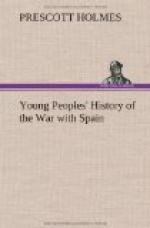Ponce, near the southern coast of Porto Rico, is a city of importance, as I have told you. It was named for Ponce de Leon, the famous voyager of the sixteenth century, who wandered around in search of a fountain of youth. When our troops approached Ponce, the city and the port were given up to them gladly, as the Spanish soldiers had gone away.
Our troops now began moving on by different roads to San Juan, on the northern coast, the capital and chief city. It was known that the Spaniards were making great preparations to defend this city. As our Army pushed on, from day to day, there were some skirmishes with the enemy. On August 12th there seemed likely to be very serious fighting at different places near San Juan, but messengers arrived suddenly, saying: “The War is ended; Spain and the United States are arranging terms of Peace.” Spain had lost Cuba and Porto Rico forever.
That afternoon, at four o’clock, the first paper of the Peace was signed at the White House, in Washington, though the full Treaty was not made until four months later. Spain agreed to give Porto Rico to the United States, Cuba to be independent, but our country to govern the island until the Cubans were able to manage their own affairs. The officers and soldiers chosen by the United States to stay in Cuba and Porto Rico to restore order and help the islands to recover from the effects of war, soon made many improvements.
As the navy began the war with Spain, it was proper that the navy should finish it. The greater events at Santiago obscured the last naval battle of the war, but it was a grand triumph for the navy. You will remember that the Wilmington was in the fight at Cardenas where brave Ensign Bagley was killed. After the destruction of Admiral Cervera’s fleet, Commander Todd, of the Wilmington, was in command of a little fleet and at Manzanillo, off to the westward of Santiago, he destroyed nine Spanish vessels. This engagement gave him the title of “the Dewey of Manzanillo,” and his report of that spirited affair was as modest as that of his namesake.
[Illustration: Commander Chapman Todd.]
As our troops came pack to the United States, from time to time, they were received with great joy. But many of our men were very ill after the war, and had to stay a long time in a sickcamp on Long Island.
On the twentieth of August there was a great naval parade in the harbor of New York, and the leading vessels from the war made a fine display.
Later, there were Peace Jubilees held in a number of cities of the United States. The one in Philadelphia was a splendid affair. There were receptions and illuminations, but what pleased the spectators most was the great parade. A great many of the military and naval commanders of the men who won the splendid victories over the Spanish were present, and thousands of the men themselves marched past the miles of spectators who lined the sidewalks, as they passed along the streets.




